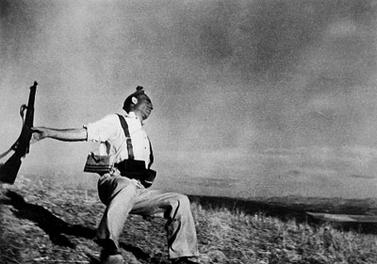Friday, 19 April 2024, 01:49 PM
Site: ONCE UPON A TIME IN... EUROPECourse: ONCE UPON A TIME IN... EUROPE (Our Online Reading Space)
Glossary: Glossary of terms
S
Spanish Civil War:The Spanish Civil War was fought from 17 July 1936 to 1 April 1939 between the Republicans, who were loyal to the established Spanish republic, and the Nationalists, a rebel group led by General Francisco Franco. The Nationalists prevailed and Franco would rule Spain for the next 36 years.  Loyalist Militiaman at the Moment of Death, Cerro Muriano, September 5, 1936, by Robert Capa. The war began after a pronunciamiento (declaration of opposition) by a group of generals of the Spanish Republican Armed Forces under the leadership of Jos? Sanjurjo against the elected government of the Second Spanish Republic, at the time under the leadership of President Manuel Aza?a. The rebel coup was supported by a number of conservative groups including the Spanish Confederation of the Autonomous Right, monarchists such as the religious conservative Carlists, and the Fascist Falange. The coup was supported by military units in Morocco, Pamplona, Burgos, Valladolid, C?diz, Cordova, and Seville. However, barracks in important cities such as Madrid, Barcelona, Valencia, Bilbao and M?laga did not join in the rebellion. Spain was thus left militarily and politically divided. The rebels, led by General Franco, then embarked upon a war of attrition against the established government for the control of the country. The rebel forces received support from Nazi Germany, the Kingdom of Italy, and neighboring Portugal, while the Soviet Union and Mexico intervened in support of the "loyalist," or Republican, side. Other countries, such as the United Kingdom and France, operated an official policy of non-intervention. Atrocities were committed by both sides in the war. Organised purges occurred in territory captured by Franco's forces to consolidate the future regime. A smaller but significant number of killings took place in areas controlled by the Republicans, normally associated with a breakdown in law and order. The extent to which killings in Republican territory were carried out with connivance of the Republican authorities varied. The Civil War became notable for the passion and political division it inspired. Tens of thousands of civilians on both sides were killed for their political or religious views, and after the War's conclusion in 1939, those associated with the losing Republicans were persecuted by the victorious Nationalists. The war ended with the victory of the Nationalists and the exile of thousands of left-leaning Spaniards, many of whom fled to refugee camps in Southern France. With the establishment of a Fascist dictatorship led by General Francisco Franco in the aftermath of the Civil War, all right-wing parties were fused into the structure of the Franco regime. (source: Wikipedia) |
Symbolism:Symbolism is the practice of representing things by symbols, or of investing things with a symbolic meaning or character. A symbol is an object, action, or idea that represents something other than itself, often of a more abstract nature. Symbolism creates quality aspects that make literature like poetry and novels more meaningful. (source: Wikipedia) |